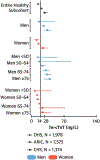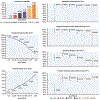Cardiovascular Biomarkers and Imaging in Older Adults: JACC Council Perspectives
- PMID: 32972536
- PMCID: PMC7540920
- DOI: 10.1016/j.jacc.2020.07.055
Cardiovascular Biomarkers and Imaging in Older Adults: JACC Council Perspectives
Abstract
Whereas the burgeoning population of older adults is intrinsically vulnerable to cardiovascular disease, the utility of many management precepts that were validated in younger adults is often unclear. Whereas biomarker- and imaging-based tests are a major part of cardiovascular disease care, basic assumptions about their use and efficacy cannot be simply extrapolated to many older adults. Biology, physiology, and body composition change with aging, with important influences on cardiovascular disease testing procedures and their interpretation. Furthermore, clinical priorities of older adults are more heterogeneous, potentially undercutting the utility of testing data that are collected. The American College of Cardiology and the National Institutes on Aging, in collaboration with the American Geriatrics Society, convened, at the American College of Cardiology Heart House, a 2-day multidisciplinary workshop, "Diagnostic Testing in Older Adults with Cardiovascular Disease," to address these issues. This review summarizes key concepts, clinical limitations, and important opportunities for research.
Keywords: aging; biomarkers; cardiovascular testing; imaging; shared decision making; stress testing.
Copyright © 2020 American College of Cardiology Foundation. All rights reserved.
Figures





References
-
- Lakatta EG, Levy D. Arterial and cardiac aging: major shareholders in cardiovascular disease enterprises: Part I: aging arteries: a “set up” for vascular disease. Circulation 2003;107: 139–46. - PubMed
-
- Lakatta EG, Levy D. Arterial and cardiac aging: major shareholders in cardiovascular disease enterprises: Part II: the aging heart in health: links to heart disease. Circulation 2003;107:346–54. - PubMed

